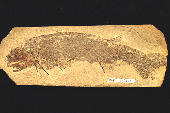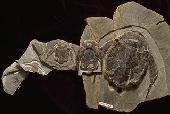|
 See More Images See More Images
(2 total)

Homalacanthus concinnus
© 2008 Miguasha National Park, Quebec

Bothriolepis canadensis
© 2008 Miguasha National Park, Quebec
|
What are Placoderms and Acanthodians? The placoderms and acanthodians arose in the Devonian and were the earliest jawed fishes. Placoderms can be recognized by their bony head and trunk shields, which are separated by a movable neck joint. Placoderms included the largest animals in the Devonian, reaching lengths of nearly 23 meters. In contrast, Acanthodians were small fish, generally less than 200 millimeters long. They had pelvic and pectoral fins modified into long spines, bony plates covering the head, and small scales covering their bodies. Placoderms were restricted mainly to the Devonian, while acanthodians went extinct in the Early Permian. First known fossil occurrence: Devonian. Last known fossil occurrence: Permian. Cool Placoderms and Acanthodians links: Search for images of Placoderms and Acanthodians on Google |
See Placoderms and Acanthodians from the:
|
|




